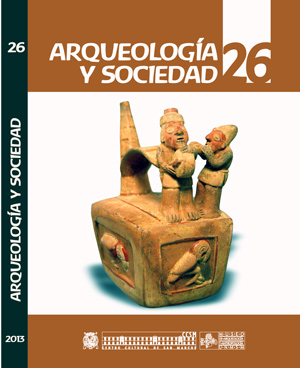ETHNOARCHAEOLOGY IN A TRADITIONAL NEIGHBORHOOD OF AYACUCHO, BASED IN ARCHAEOLOGICAL MONITORING
DOI:
https://doi.org/10.15381/arqueolsoc.2013n26.e12418Keywords:
Cultural occupation, the Huarpa nobility, Wari, funerary contexts, ceramic production.Abstract
We present archaeological, ethnohistorical and ethnographic to know and understand the cultural roots of the Santa Ana in Ayacucho, established in an area with human occupation since at least the Formative period, according to material culture evidence recorded in the nearby settlements of Pilacucho, Andamarca Waychaupampa and in the neighborhood of Santa Ana, whose square drawn in the colonial era is on the cultural vestiges Huarpa and Wari, during this last period the inhabitants were devoted to the production of pottery, something similar to what was happening in villages and Acuchimay Conchopata. Reference is made of clay outcrops and around the square which had to be used as quarries, presence of human burials in tombs with stone walls and simple pits dug into sterile soil as part of a funeral industry, and remains a midden with abundant ceramic with a high proportion Wari dispersed in the basement of the northeast corner of said open space.Downloads
Published
Issue
Section
License
Copyright (c) 2013 Ismael Pérez Calderón

This work is licensed under a Creative Commons Attribution-NonCommercial-ShareAlike 4.0 International License.
THE AUTHORS RETAIN THEIR RIGHTS:
a. The authors retain their trademark and patent rights, and also on any process or procedure described in the article.
b. The authors retain the right to share, copy, distribute, perform and publicly communicate the article published in the Arqueología y Sociedad (for example, place it in an institutional repository or publish it in a book), with an acknowledgment of its initial publication in the Arqueología y Sociedad.
c. The authors retain the right to make a subsequent publication of their work, to use the article or any part of it (for example: a compilation of their works, notes for conferences, thesis, or for a book), provided that they indicate the source. of publication (authors of the work, journal, volume, number and date).






